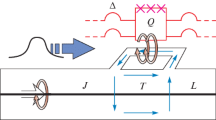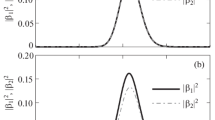Abstract
We describe the interaction between the qubit and the electromagnetic field in a waveguide in accordance with the Lee model using the fact that photons in the waveguide are quanta of a massive scalar neutral field. We study the case where the energy of the excited state of the qubit is larger than the photon mass. We find the stationary state of the “qubit \(+\) electromagnetic field ” system. We describe the evolution of nonstationary states under initial conditions of the general form. We present results of numerical calculations under the initial conditions of two types: 1) the qubit is in the excited state, and there is no photon; 2) the qubit is in the ground state, and the photon is present. The study is related to the consistent quantum theory of the qubit control with the goal to force qubits to make transitions from one state to another.





Similar content being viewed by others
Notes
It is easy to verify this by differentiating with respect to the time and using the fact that the functions \(e^{-ikz+i\omega(k)t}\) and \(f(z,t)\) and the field \(\hat{\phi}(z,t)\) are solutions of the same Klein–Gordon equation (4).
The authors are grateful to the referee for the statement of this problem.
References
A. I. Kirillov and E. V. Polyachenko, “Travel time of a quantum particle through a given domain,” Theoret. and Math. Phys., 118, 41–53 (1999).
P. Facchi, M. S. Kim, S. Pascazio, F. V. Pepe, D. Pomarico, and T. Tufarelli, “Bound states and entanglement generation in waveguide quantum electrodynamics,” Phys. Rev. A, 94, 043839, 10 pp. (2016).
A. S. Holevo, “Kvantovaya informatika: proshloe, nastoyashchee, budushchee,” V mire nauki, 68–75 (2008) [in Russian].
V. S. Kalashnikov, A. V. Prusov, Tekhnicheskaya elektrodinamika. Napravlyayushchie sistemy i napravlyaemye volny, SPbGUAP, SPb (2001).
J. D. Jackson, Classical Electrodynamics, Wiley, New York (1998).
A. N. Pechen and N. B. Il’in, “Coherent control of a qubit is trap-free,” Proc. Steklov Inst. Math., 285, 233–240 (2014).
E. T. Jaynes and F. W. Cummings, “Comparison of quantum and semiclassical radiation theories with application to the beam maser,” Proc. IEEE, 51, 89–109 (1963).
T. D. Lee, “Some special examples in renormalizable field theory,” Phys. Rev., 95, 1329–1334 (1954).
G. Barton, Introduction to Advanced Field Theory, Interscience (Wiley), New York (1963).
H. Bateman and A. Erdelyi, Tables of Integral Transforms, Vol. 1: Fourier, Laplace, Mellin Transforms (1954).
H. Bateman and A. Erdelyi, Higher Transcendental Functions, Vol. 2: Bessel Functions, Functions of Parabolic Cylinder, Orthogonal Polynomials, Nauka, Moscow (1966).
B. M. Garraway, “Nonperturbative decay of an atomic system in a cavity,” Phys. Rev. A, 55, 2290–2303 (1997).
N. G. Van Kampen, “On the theory of stationary waves in plasmas,” Physica, 21, 949–963 (1955).
K. M. Case, “Plasma oscillations,” Ann. Phys., 7, 349–364 (1959).
E. V. Polyachenko, I. G. Shukhman, and O. I. Borodina, “Damped perturbations in stellar systems: genuine modes and Landau-damped waves,” Monthly Notices Roy. Astron. Soc., 503, 660–668 (2021).
Funding
The work was supported by the Theoretical Physics and Mathematics Advancement Foundation “BASIS” (Grant No. 20-1-2-33).
Author information
Authors and Affiliations
Corresponding author
Ethics declarations
The authors declare no conflicts of interest.
Additional information
Translated from Teoreticheskaya i Matematicheskaya Fizika, 2021, Vol. 208, pp. 218-232 https://doi.org/10.4213/tmf10086.
Rights and permissions
About this article
Cite this article
Kirillov, A.I., Polyachenko, E.V. On the evolution of states of controlled qubits. Theor Math Phys 208, 1038–1050 (2021). https://doi.org/10.1134/S0040577921080043
Received:
Revised:
Accepted:
Published:
Issue Date:
DOI: https://doi.org/10.1134/S0040577921080043




